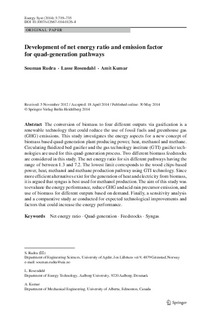Development of net energy ratio and emission factor for quad-generation pathways
Journal article, Peer reviewed
Permanent lenke
http://hdl.handle.net/11250/276616Utgivelsesdato
2014Metadata
Vis full innførselSamlinger
Originalversjon
Rudra, S., Rosendahl, L., & Kumar, A. (2014). Development of net energy ratio and emission factor for quad-generation pathways. Energy Systems, 5(4), 719-735. doi: 10.1007/s12667-014-0126-4 10.1007/s12667-014-0126-4Sammendrag
The conversion of biomass to four different outputs via gasification is a renewable technology that could reduce the use of fossil fuels and greenhouse gas (GHG) emissions. This study investigates the energy aspects for a new concept of biomass based quad-generation plant producing power, heat, methanol and methane. Circulating fluidized bed gasifier and the gas technology institute (GTI) gasifier technologies are used for this quad-generation process. Two different biomass feedstocks are considered in this study. The net energy ratio for six different pathways having the range of between 1.3 and 7.2. The lowest limit corresponds to the wood chips-based power, heat, methanol and methane production pathway using GTI technology. Since more efficient alternatives exist for the generation of heat and electricity from biomass, it is argued that syngas is best used for methanol production. The aim of this study was to evaluate the energy performance, reduce GHG and acid rain precursor emission, and use of biomass for different outputs based on demand. Finally, a sensitivity analysis and a comparative study ar conducted for expected technological improvements and factors that could increase the energy performance.
Beskrivelse
Published version of an article in the journal: Energy Systems. Also available from the publisher at: http://dx.doi.org/10.1007/s12667-014-0126-4
